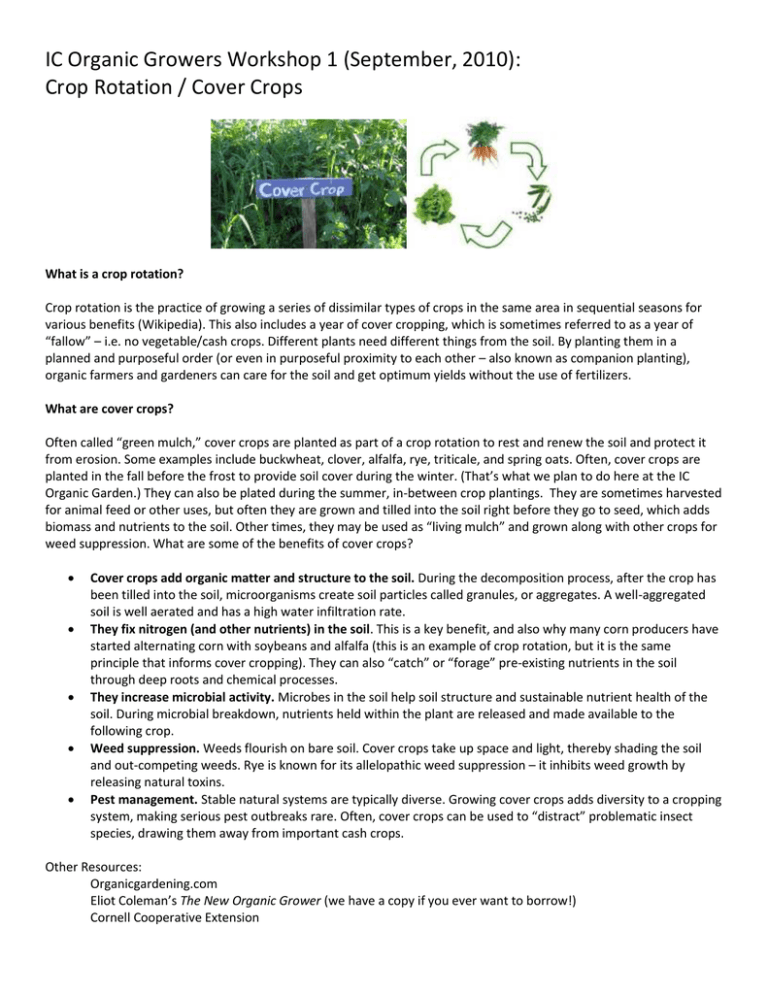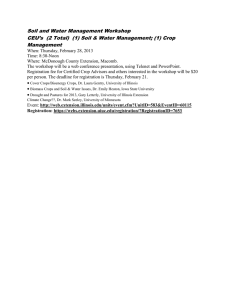Download Organic Growers Workshop #1 - Fall 2010
advertisement

IC Organic Growers Workshop 1 (September, 2010): Crop Rotation / Cover Crops What is a crop rotation? Crop rotation is the practice of growing a series of dissimilar types of crops in the same area in sequential seasons for various benefits (Wikipedia). This also includes a year of cover cropping, which is sometimes referred to as a year of “fallow” – i.e. no vegetable/cash crops. Different plants need different things from the soil. By planting them in a planned and purposeful order (or even in purposeful proximity to each other – also known as companion planting), organic farmers and gardeners can care for the soil and get optimum yields without the use of fertilizers. What are cover crops? Often called “green mulch,” cover crops are planted as part of a crop rotation to rest and renew the soil and protect it from erosion. Some examples include buckwheat, clover, alfalfa, rye, triticale, and spring oats. Often, cover crops are planted in the fall before the frost to provide soil cover during the winter. (That’s what we plan to do here at the IC Organic Garden.) They can also be plated during the summer, in-between crop plantings. They are sometimes harvested for animal feed or other uses, but often they are grown and tilled into the soil right before they go to seed, which adds biomass and nutrients to the soil. Other times, they may be used as “living mulch” and grown along with other crops for weed suppression. What are some of the benefits of cover crops? Cover crops add organic matter and structure to the soil. During the decomposition process, after the crop has been tilled into the soil, microorganisms create soil particles called granules, or aggregates. A well-aggregated soil is well aerated and has a high water infiltration rate. They fix nitrogen (and other nutrients) in the soil. This is a key benefit, and also why many corn producers have started alternating corn with soybeans and alfalfa (this is an example of crop rotation, but it is the same principle that informs cover cropping). They can also “catch” or “forage” pre-existing nutrients in the soil through deep roots and chemical processes. They increase microbial activity. Microbes in the soil help soil structure and sustainable nutrient health of the soil. During microbial breakdown, nutrients held within the plant are released and made available to the following crop. Weed suppression. Weeds flourish on bare soil. Cover crops take up space and light, thereby shading the soil and out-competing weeds. Rye is known for its allelopathic weed suppression – it inhibits weed growth by releasing natural toxins. Pest management. Stable natural systems are typically diverse. Growing cover crops adds diversity to a cropping system, making serious pest outbreaks rare. Often, cover crops can be used to “distract” problematic insect species, drawing them away from important cash crops. Other Resources: Organicgardening.com Eliot Coleman’s The New Organic Grower (we have a copy if you ever want to borrow!) Cornell Cooperative Extension




